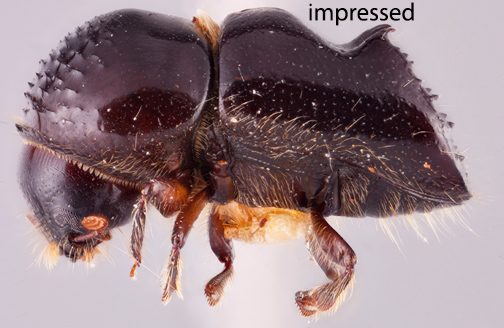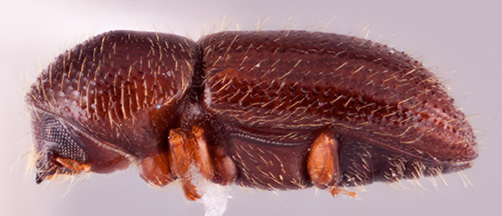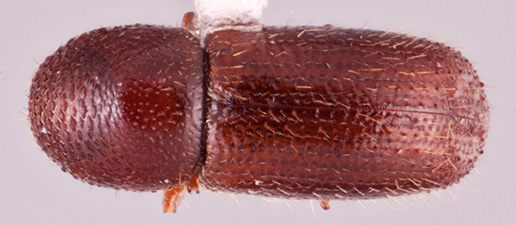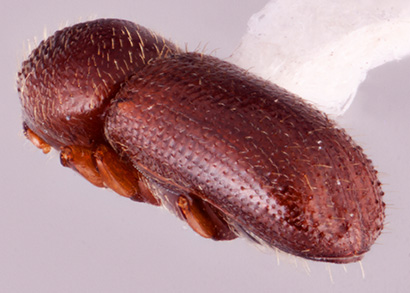Heteroborips seriatus
|
Heteroborips seriatus lateral; R.K. Osborn |
|
Heteroborips seriatus dorsal; R.K. Osborn |
|
Heteroborips seriatus declivity; R.K. Osborn |
|
Heteroborips seriatus frontal; R.K. Osborn |
Taxonomic history
Xyleborus seriatus Blandford, 1894b: 111.
Heteroborips seriatus (Blandford): Mandelshtam et al., 2019: 392.
Synonyms
Xyleborus orientalis Eggers, 1933b: 54. Mandelshtam, 2006: 324.
Xyleborus todo Kôno, 1938: 71. Smith et al. 2018b: 399.
Xyleborus orientalis kalopanacis Kurentzov, 1941: 187. Knížek, 2011: 249.
Xyleborus orientalis aceris Kurentzov, 1941: 188. Knížek, 2011: 249.
Xyleborus perorientalis Schedl, 1957: 85. Unnecessary replacement name. Knížek, 2011: 249.
Diagnosis
2.5−2.9 mm long (mean = 2.64 mm; n = 5); 2.78−3.0 times as long as wide. This species is distinguished by the distinctive elytralelytral:
pertaining to the elytra
mycangium appearing as a distinctly impressedimpressed:
a depression in a surface
 area immediately adjacent to the scutellumscutellum:
area immediately adjacent to the scutellumscutellum:
a shield-like sclerotized plate located at the midpoint of the elytral base
on each elytronelytron:
the two sclerotized forewings of beetles that protect and cover the flight wings
, margins flush with elytralelytral:
pertaining to the elytra
suface; and elytralelytral:
pertaining to the elytra
declivitydeclivity:
downward slope of either the pronotum or elytra
 steeply sloping, occupying apicalapex:
steeply sloping, occupying apicalapex:
point or edge furthest from the body; opposite of base
 quarter of elytraelytron:
quarter of elytraelytron:
the two sclerotized forewings of beetles that protect and cover the flight wings
.
May be confused with
Heteroborips indicus
Distribution
China (Shaanxi, Shanxi, Sichuan), Japan, South & North Korea, Russia (Far East, Kuril Islands); introduced and established in USA (Hoebeke and Rabaglia 2008Hoebeke and Rabaglia 2008:
Hoebeke ER, Rabaglia RJ. 2008. Xyleborus seriatus Blandford (Coleoptera: Curculionidae: Scolytinae), an Asian ambrosia beetle new to North America. Proceedings of the Entomological Society of Washington 110: 470-476.)
Host plants
polyphagous, attacking both conifers and angiosperms (Hoebeke and Rabaglia 2008Hoebeke and Rabaglia 2008:
Hoebeke ER, Rabaglia RJ. 2008. Xyleborus seriatus Blandford (Coleoptera: Curculionidae: Scolytinae), an Asian ambrosia beetle new to North America. Proceedings of the Entomological Society of Washington 110: 470-476.)
Remarks
The gallery system is unusual in lying between the bark and wood and not penetrating the wood. The parent female, larvae, and pupae are all found together in communal chambers under the bark (Murayama 1955Murayama 1955:
Murayama J. 1955. Supplementary notes on the scolytid-fauna of Japan. Bulletin of the Faculty of Agriculture, Yamaguti University 6: 81-106, pls. 3-4., Nakashima et al. 1992Nakashima et al. 1992:
Nakashima T, Otomo T, Owada Y, Iizuka T. 1992. SEM observations on growing conditions of the fungi in the galleries of several ambrosia beetles: (Coleoptera: Scolytidae and Platypodidae). Journal of the Faculty of Agriculture, Hokkaido University 65: 239-273.).
DNA data
Sequences available for COI and CAD.
COI: HM064138
CAD: HM064316





